A Cloud Information Monitoring and Recommendation Multi-Agent System with Friendly Interfaces for Tourism
Abstract
1. Introduction
2. Literature Analysis and Discussion and Development Technology
3. Proposed System Technology, Architecture, and Operation
3.1. Domain Ontology and Related Ontology Services
3.2. Building UAI-Based LOD Access Technology
3.3. Architecture of WIAS
3.4. Design and Construction of Dr. What-Info System with CEOntoIAS
3.5. Establishment of System Front-End APP
4. Evaluation of System Presentation and Efficacy
4.1. System Presentation
4.2. System Evaluation
5. Conclusions and Discussion
- (1)
- This study established three-tier address-based, UAI-based LOD access technology by actively developing the proposed system with friendly interfaces that assist users in quickly, accurately, and effectively obtaining relevant and timely useful links and open information.
- (2)
- With the operational support of CEOntoIAS, this study established a cloud interactive paradigm supported by web services through the corresponding query semantic content with the CURRL in JSON format. With the support of three-stage intelligent decision-making, such as OntoDMA, OntoCBRA, and OntoIAS, the proposed system APPs autonomously and effectively added value to the quality of the monitoring and to the recommendation of intelligent tourism information. Therefore, this study is unique and different from other information agents found in the literature.
Author Contributions
Acknowledgments
Conflicts of Interest
References
- Yalçınkaya, P.; Atay, L.; Korkmaz, H. An Evaluation on Smart Tourism. China-USA Bus. Rev. 2018, 17, 308–315. [Google Scholar] [CrossRef][Green Version]
- Khan, S.; Shariff, S.; Ahmad, A.; Alam, M.S. A Comprehensive Review on Level 2 Charging System for Electric Vehicles. Smart Sci. 2018, 6, 1–23. [Google Scholar] [CrossRef]
- Ylijoki, O.; Porras, J. Perspectives to Definition of Big Data: A Mapping Study and Discussion. J. Innov. Manag. 2016, 4, 69–91. [Google Scholar] [CrossRef]
- Auer, S.; Bizer, C.; Kobilarov, G.; Lehmann, J.; Cyganiak, R.; Ives, Z. Dbpedia: A Nucleus for a Web of Open Data. In The Semantic Web; Springer: Berlin/Heidelberg, Germany, 2007; Volume 4825, pp. 722–735. [Google Scholar]
- Chen, W.C.; Chen, W.H.; Yang, S.Y. A Big Data and Time Series Analysis Technology-Based Multi-Agent System for Smart Tourism. Appl. Sci. 2018, 8, 947. [Google Scholar] [CrossRef]
- Yang, S.Y.; Hsu, C.L. A location-based services and Google maps-based information master system for tour guiding. Comput. Electr. Eng. 2016, 54, 87–105. [Google Scholar] [CrossRef]
- Chen, K.Y.; Chen, F.H.; Yang, S.Y. An Upgraded Intelligent Mobile Information Multi-Agent System with Universal Application Interfaces based on Open Data of Taiwan Government. J. Comput. Appl. Sci. Educ. 2017, 4, 1–23. [Google Scholar]
- Lin, H.Y.; Yang, S.Y. A Smart Cloud-Based Energy Data Mining Agent Using Big Data Analysis Technology. Smart Sci. 2019, 7, 175–183. [Google Scholar] [CrossRef]
- Shah, N.; Martin, G.; Archer, S.; Arora, S.; King, D.; Darzi, A. Exploring mobile working in healthcare: Clinical perspectives on transitioning to a mobile first culture of work. Int. J. Med. Inform. 2019, 125, 96–101. [Google Scholar] [CrossRef]
- Yang, S.Y. OntoIAS: An ontology-supported information agent shell for ubiquitous services. Expert Syst. Appl. 2011, 38, 7803–7816. [Google Scholar] [CrossRef]
- Yang, S.Y. A novel cloud information agent system with Web service techniques: Example of an energy-saving multi-agent system. Expert Syst. Appl. 2013, 40, 1758–1785. [Google Scholar] [CrossRef]
- Ke, F.Y. The Willingness and Analysis of the Application of the Health Insurance Integrate Wearable Devices at Personal Health Management. Master’s Thesis, Tamkang University, Taipei City, Taiwan, 2016. [Google Scholar]
- Preuveneers, D.; Joosen, W. Privacy-enabled remote health monitoring applications for resource constrained wearable devices. In Proceedings of the 31st Annual ACM Symposium on Applied Computing—SAC ’16, Pisa, Italy, 4–8 April 2016; pp. 119–124. [Google Scholar]
- Adapa, A.; Nah, F.F.H.; Hall, R.H.; Siau, K.; Smith, S.N. Factors Influencing the Adoption of Smart Wearable Devices. Int. J. Hum. Comput. Interact. 2018, 34, 399–409. [Google Scholar] [CrossRef]
- Jiang, Q.; Qian, Y.; Ma, J.; Ma, X.; Cheng, Q.; Wei, F. User Centric Three-factor Authentication Protocol for Cloud-assisted Wearable Devices. Int. J. Commun. Syst. 2019, 32, e3900. [Google Scholar] [CrossRef]
- Yu, C.Y. Research on Linked Open Data Applications Using Dynamic Context Data Analysis. Master’s Thesis, National Taiwan Normal University, Taipei City, Taiwan, 2016. [Google Scholar]
- Alobaidi, M.; Mahmood, K.; Sabra, S. Semantic Enrichment for Local Search Engine using Linked Open Data. In Proceedings of the 25th International Conference Companion on World Wide Web, Montréal, QC, Canada, 11–15 April 2016; pp. 631–634. [Google Scholar]
- Musto, C.; Basile, P.; Lops, P.; De Gemmis, M.; Semeraro, G. Introducing linked open data in graph-based recommender systems. Inf. Process. Manag. 2017, 53, 405–435. [Google Scholar] [CrossRef]
- Sansonetti, G.; Gasparetti, F.; Micarelli, A.; Cena, F.; Gena, C. Enhancing cultural recommendations through social and linked open data. User Model. User Adapt. Interact. 2019, 29, 121–159. [Google Scholar] [CrossRef]
- Bellavista, P.; Küpper, A.; Helal, S. Location-Based Services: Back to the Future. IEEE Pervasive Comput. 2008, 7, 85–89. [Google Scholar] [CrossRef]
- Hsu, C.M. The Relationship between Location-Based Service Quality and Satisfaction—Using Uber as an Example. Master’s Thesis, Soochow University, Taipei City, Taiwan, 2016. [Google Scholar]
- Wang, Y.; Xu, D.; Li, F. Providing location-aware location privacy protection for mobile location-based services. Tsinghua Sci. Technol. 2016, 21, 243–259. [Google Scholar] [CrossRef]
- Sun, Y.; Chen, M.; Hu, L.; Qian, Y.; Hassan, M.M. ASA: Against statistical attacks for privacy-aware users in Location Based Service. Future Gener. Comput. Syst. 2017, 70, 48–58. [Google Scholar] [CrossRef]
- Jang, S.H.; Lee, C.W. The Impact of Location-Based Service Factors on Usage Intentions for Technology Acceptance: The Moderating Effect of Innovativeness. Sustainability 2018, 10, 1876. [Google Scholar] [CrossRef]
- Sun, P.L. The Adaptive Composition of Web Services Based on a Novel Trust and Reputation Model. Ph.D. Thesis, National Chung Cheng University, Chiayi, Taiwan, 2016. [Google Scholar]
- Wei, C.H.; Leaman, R.; Lu, Z. Beyond accuracy: Creating interoperable and scalable text-mining web services. Bioinformatics 2016, 32, 1907–1910. [Google Scholar] [CrossRef][Green Version]
- Yoshiura, V.T.; De Azevedo-Marques, J.M.; Rzewuska, M.; Vinci, A.L.T.; Sasso, A.M.; Miyoshi, N.S.B.; Furegato, A.R.F.; Rijo, R.P.C.L.; Del-Ben, C.M.; Alves, D. A web-based information system for a regional public mental healthcare service network in Brazil. Int. J. Ment. Health Syst. 2017, 11, 1. [Google Scholar] [CrossRef]
- Ghavami, S.M. A web service based advanced traveller information system for itinerary planning in an uncertain multimodal network. Geocarto Int. 2019, 34, 1–16. [Google Scholar] [CrossRef]
- Amato, F.; Moscato, V.; Picariello, A.; Sperlí, G. Recommendation in Social Media Networks. In Proceedings of the 2017 IEEE 3rd International Conference on Multimedia Big Data, Laguna Hills, CA, USA, 19–21 April 2017; pp. 213–216. [Google Scholar]
- Amato, F.; Moscato, V.; Picariello, A.; Sperlí, G. Kira: A system for knowledge-based access to multimedia art collections. In Proceedings of the 2017 IEEE 11th International Conference on Semantic Computing, San Diego, CA, USA, 30 January–1 February 2017; pp. 338–343. [Google Scholar]
- Yang, S.Y. Developing an energy-saving and case-based reasoning information agent with Web service and ontology techniques. Expert Syst. Appl. 2013, 40, 3351–3369. [Google Scholar] [CrossRef]
- Lin, H.Y.; Yang, S.Y. A cloud-based energy data mining information agent system based on big data analysis technology. Microelectron. Reliab. 2019, 97, 66–78. [Google Scholar] [CrossRef]
- Tsai, S. ASUS Cloud employs ASUS Cloud Platform to Accelerate Innovation and Promote the Interconnection of all Things for Vibrating New Economic System of APIs; White Paper, ASUS Cloud Solution Day; ASUS: Taipei, Taiwan, 2014. [Google Scholar]
- Tsai, Y.J. A Research and Development of an Intelligent Monitoring and Consultation Agent System for Personal Health Information with Mobile and Wearable Devices. Master’s Thesis, St. John’s University, Taipei City, Taiwan, 2016. [Google Scholar]
- Tsai, Y.H. Development of an Omni-Restaurant Information Consultation and Sharing Agent System with GPS and Linked Open Data Technologies. Master’s Thesis, St. John’s University, New Taipei City, Taiwan, 2016. [Google Scholar]
- Ku, C.L. Development of a Safety Drinking Agent System with the QR Code & LOD Technologies. Master’s Thesis, St. John’s University, Taipei City, Taiwan, 2016. [Google Scholar]
- Tu, T.A. A Refrigerated Cargo Tracking System Using GPS, Google Map API and PHP Web Service. Master’s Thesis, Da-Yen University, Changhua, Taiwan, 2013. [Google Scholar]
- Ha, J.S. A Human-machine Interface Evaluation Method Based on Balancing Principles. Procedia Eng. 2014, 69, 13–19. [Google Scholar] [CrossRef]

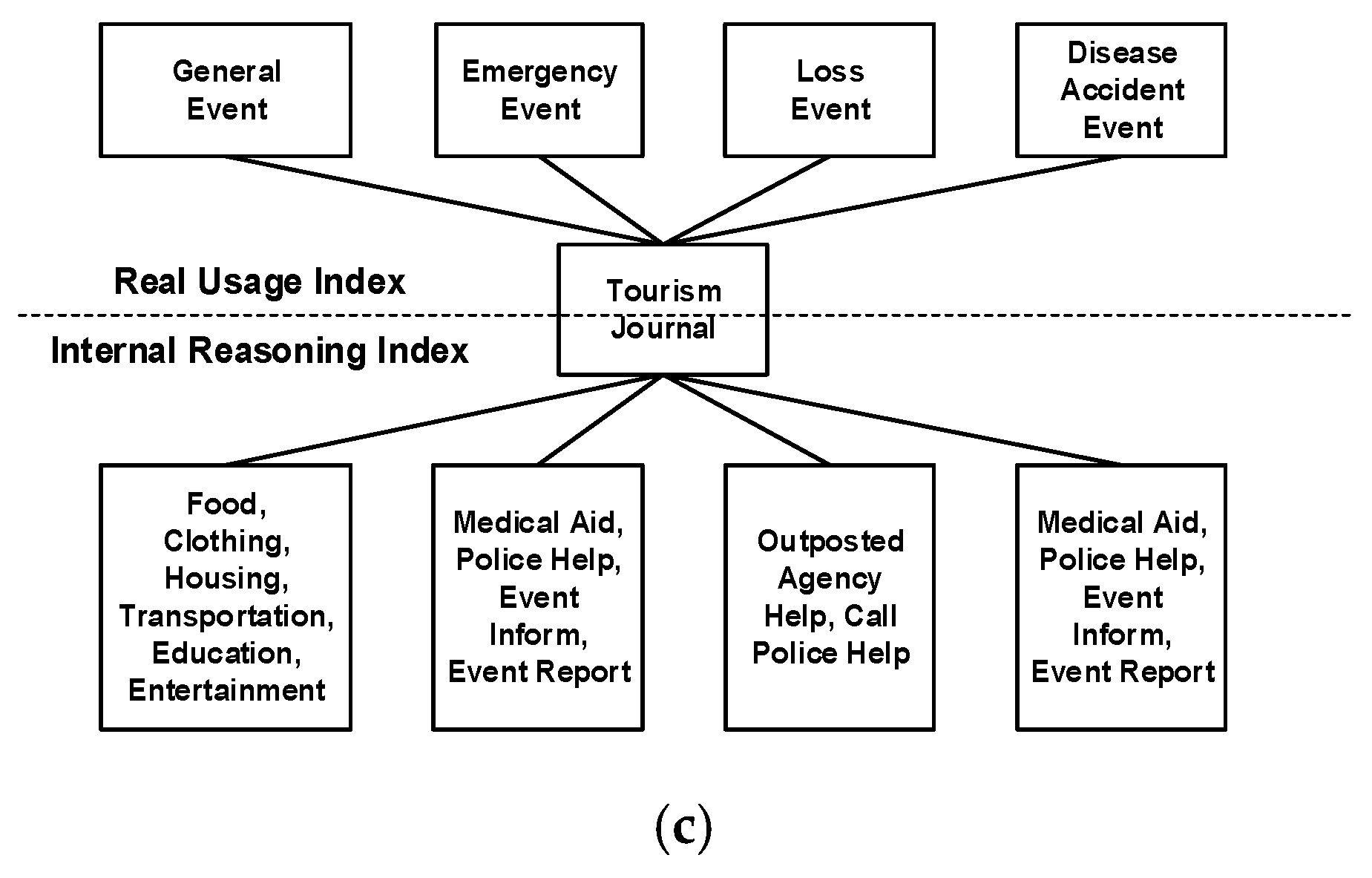
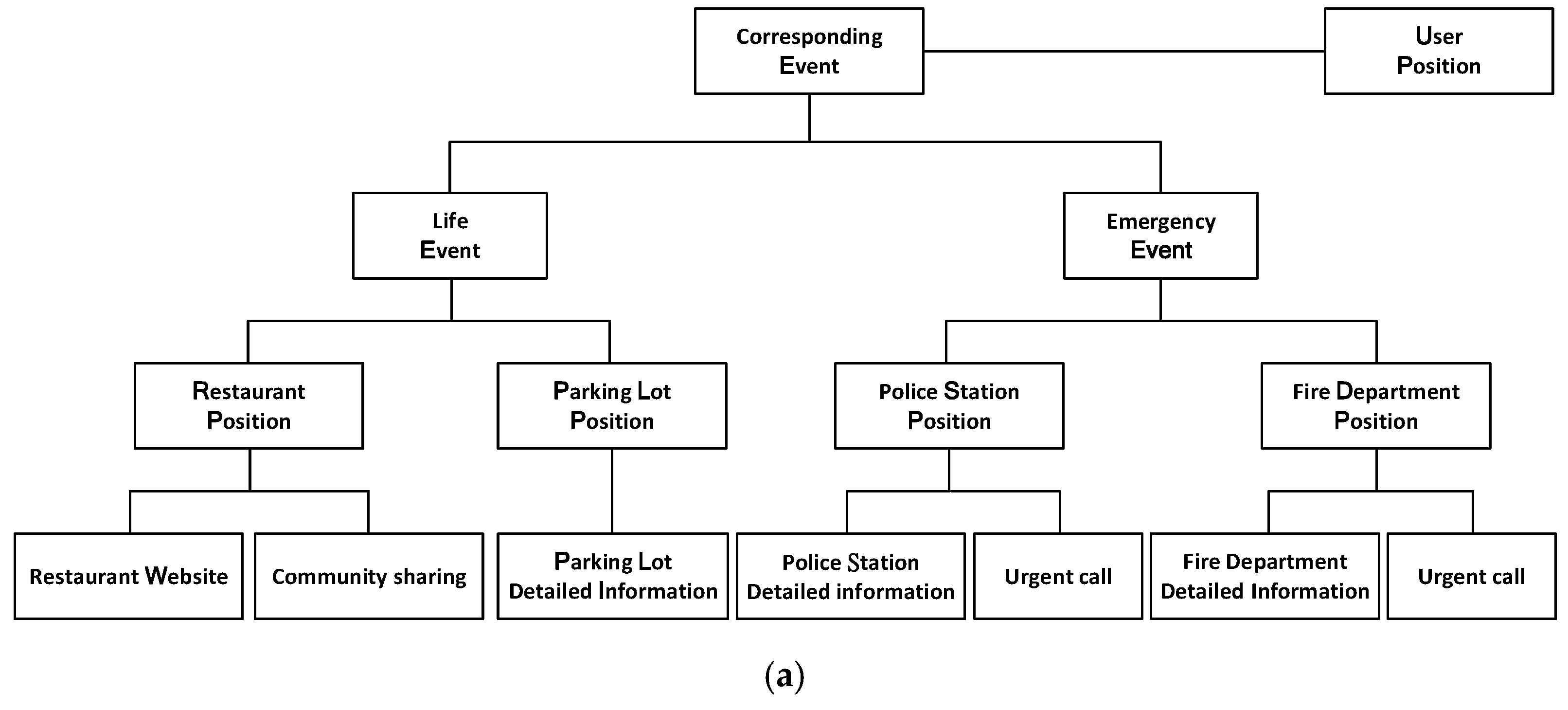

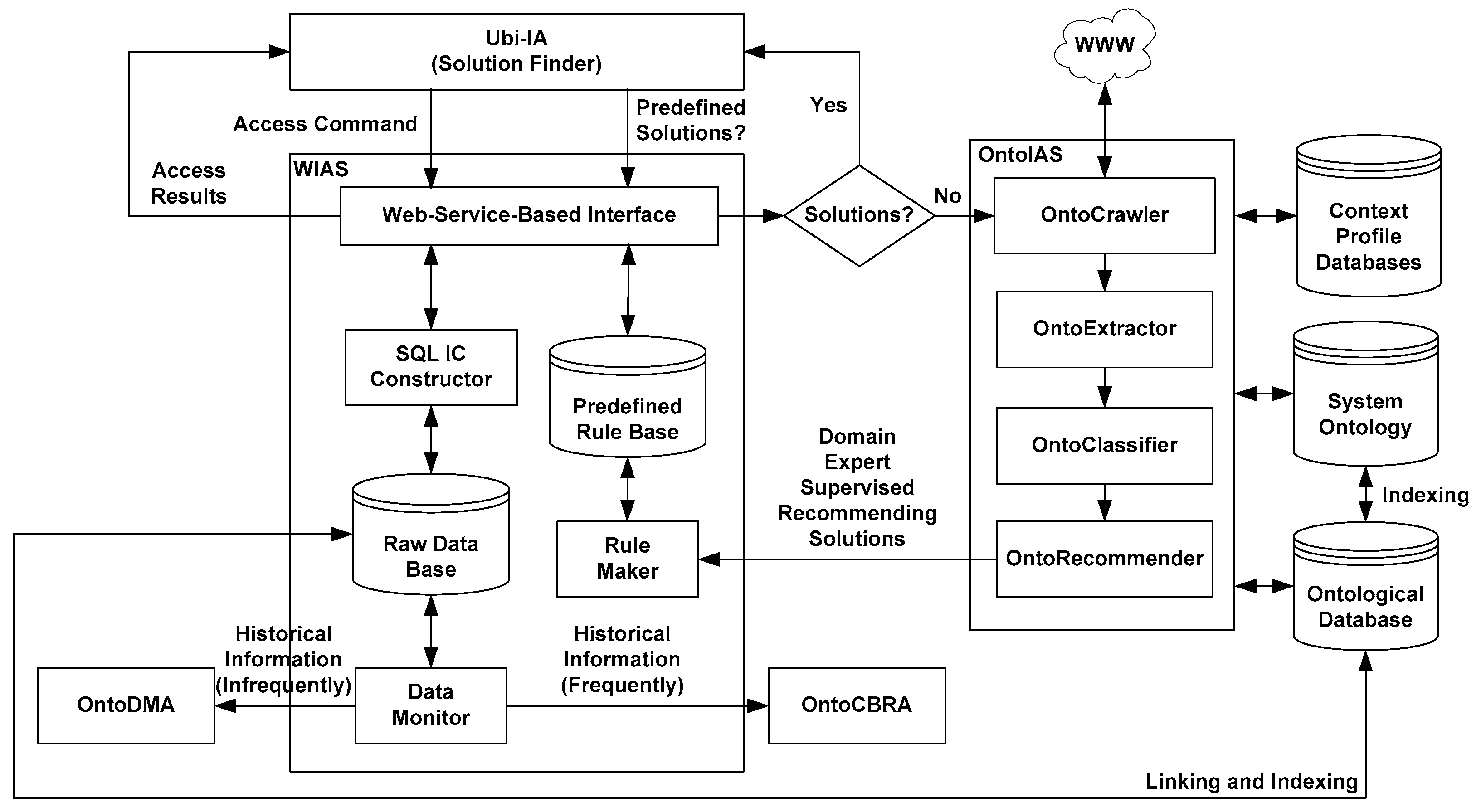
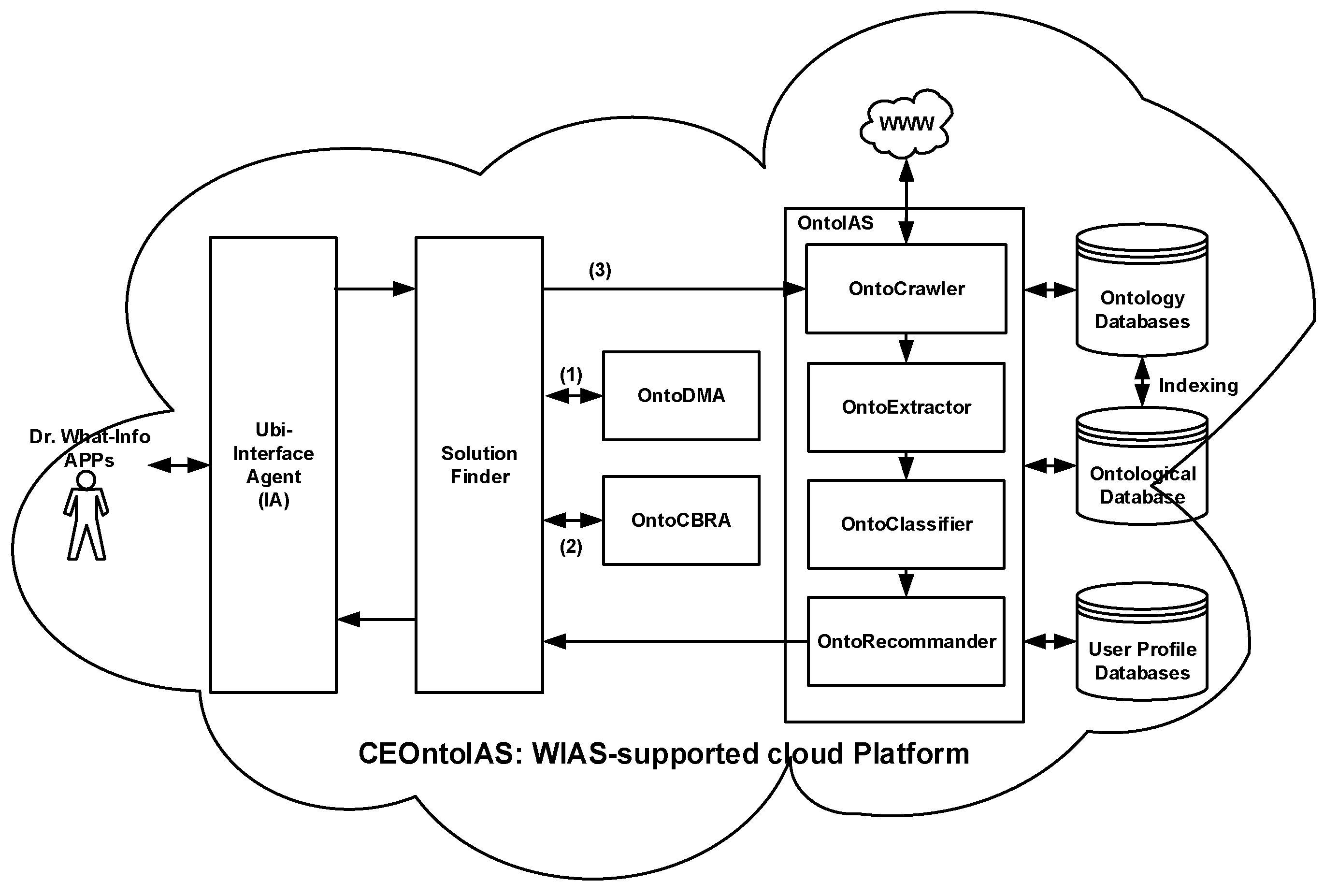
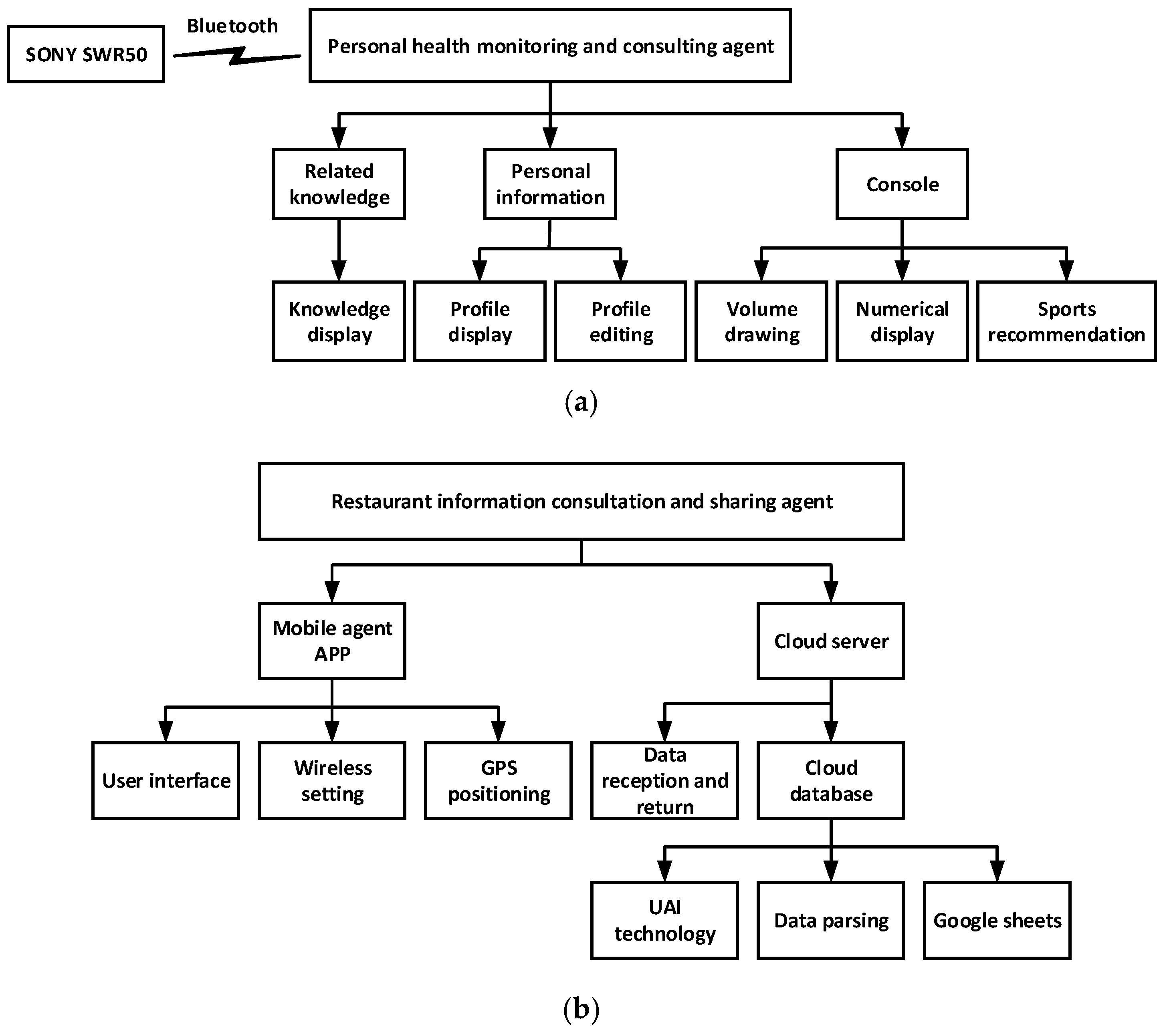
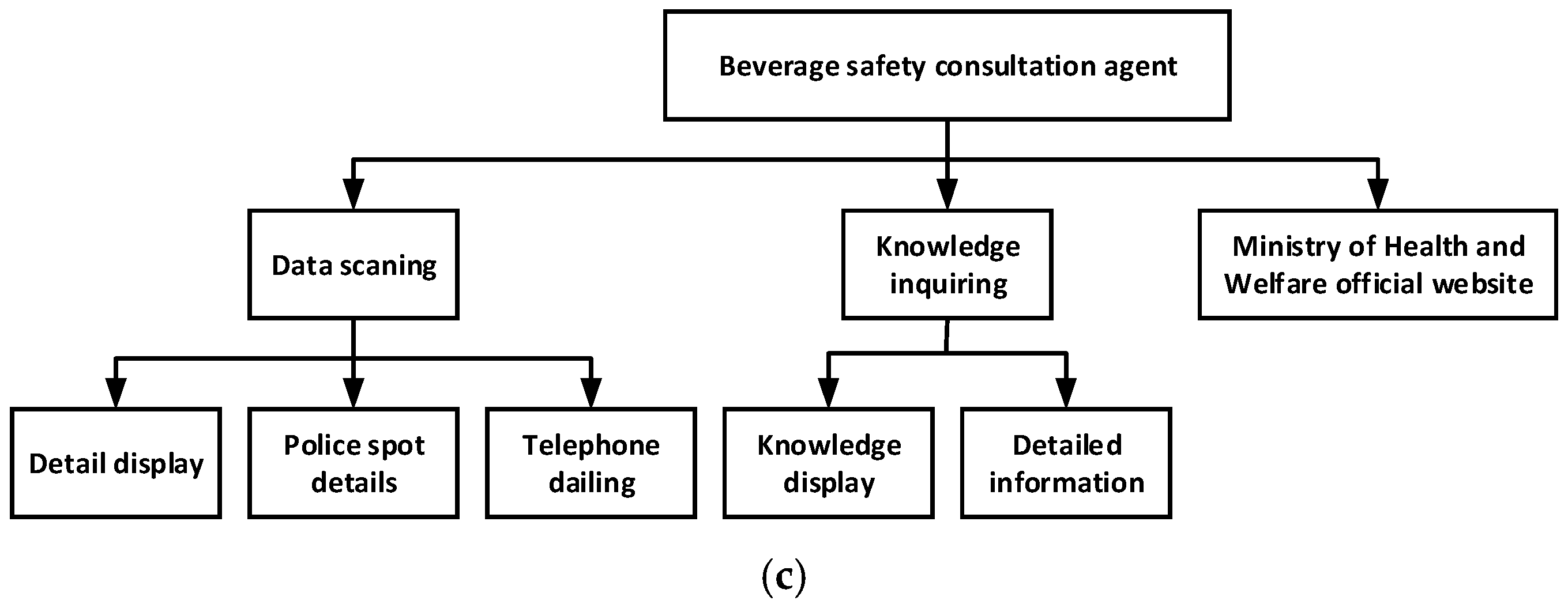

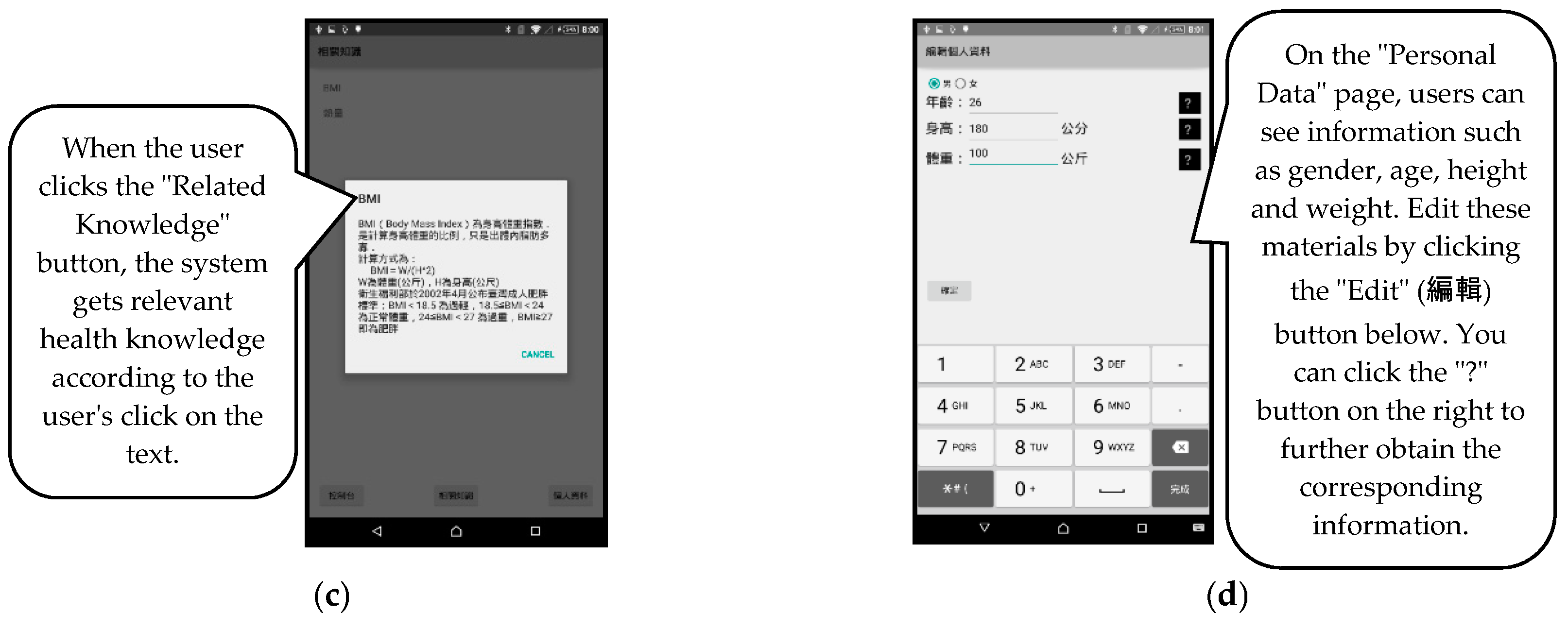


| SERVICE NAME | SERVICE DESCRIPTION | TO WHOM |
|---|---|---|
| CBR_InsTmpCaseData | Adds temporary data for solutions | CBR Agent |
| CBR_Solutions | Solution to case library | CBR Agent |
| DB_InsCaseBase | Adds case base rule | Sharing |
| DB_InsPrediction | Adds a prediction rule | Sharing |
| DB_UptCaseBase | Records whether it been converted | Sharing |
| DB_UptRawData | Records whether it been converted | Sharing |
| DM_Solutions | Solution to prediction rules | Data Mining Agent |
| DM_TransCaseToPred | Converts from a semantic case library to a prediction rule library | Data Mining Agent |
| DM_ViewCaseBase | Views case base | Data Mining Agent |
| IA_InsRawData | Adds original data | Interface Agent |
| IA_Solutions | Solution to redefined rules | Interface Agent |
| Share_DelUniqueTables | Deletes the data in each independent data table | Sharing |
| Share_IsNumeric | Determines whether str NUMBER is a number | Sharing |
| Share_ViewCBR | Views case library summary | Sharing |
| Share_ViewDBSDT | Views system time | Sharing |
| UAI_ConnectCrossDomain | Connects cross-domain Open Data Base | UAI_Connect |
| UAI_ConnectAlertReg | Links registration tips | UAI_Connect |
| UAI_ConnectRuleSetting | Connects rule settings | UAI_Connect |
| UAI_ComputeFileAccess | File access computation | UAI_Compute |
| UAI_ComputeTimeSeriesAccess | Time series computation | UAI_Compute |
| UAI_ComputeTriggerConfig | Triggers configuration computation | UAI_Compute |
| UAI_SearchTimeSeries | Time series search | UAI_Search |
| UAI_SearchBuildIndexFields | Creates an index field | UAI_Search |
| UAI_SearchStatistics | Searches statistics | UAI_Search |
| UAI_StorageFFStatus | Folder and file status | UAI_Storage |
| UAI_StorageFFManipulation | Folder and file operation | UAI_Storage |
| UAI_StorageFTransimission | Folder and file transmission and status | UAI_Storage |
| UAI_StorageFFSharing | Folder and file sharing and integration | UAI_Storage |
| Slots | Description |
|---|---|
| Theme | Topic of user’s command |
| aTheme | Description of topic |
| tTime | Related time of topic |
| tSpace | Related space of topic |
| object | Topic objects |
| oIdentity | Object description |
| oCardinality | Number of objects |
| oTime | Related time of object |
| oSpace | Related space of object |
| QUERY COMMAND | CURRL |
|---|---|
| What is St. John’s University (SJU), Taiwan? | Query [Theme = +SJU, aTheme = Taiwan, tSpace = At (WWW)] |
| Anything else? | Command [ Theme = +Anymore, tTime = Now, object = Related, oSpace = At (Last-one) |
| Retrieving Taiwan SJU webpages with the exception of New York SJU | ConditionalCommand [ Condition [Theme = −N.Y. SJU, tTime = Now, tSpace = At (WWW)], Command [Theme = +Taiwan SJU, tTime = Now, tSPace = At (WWW)]] |
| Google Fit | Millet Movement | Motion-Pedometer | PHI Agent | |
|---|---|---|---|---|
| User profile | ✓ | ✓ | ✓ | ✓ |
| Display method | Line chart/bar graph 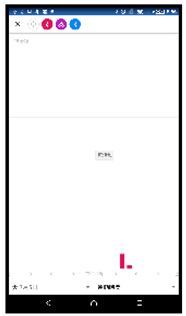 | Bar graph | Bar graph | Bar graph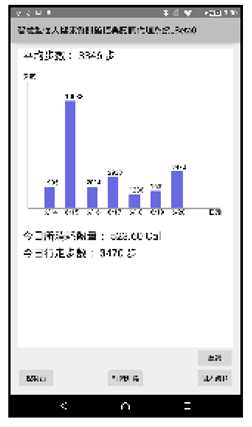 |
| Query the number of steps in the day | ✓ | ✓ | ✓ | ✓ |
| Query the calories on the day | ✓ | ✓ | ✓ | ✓ |
| Google Fit | Millet Movement | Motion-Pedometer | PHI Agent | |
|---|---|---|---|---|
| Query the number of steps in the month | ✓ | ✓ | ✘ | ✘ |
| Query the calories in the month | ✓ | ✓ | ✘ | ✘ |
| Related knowledge | ✘ | ✘ | ✘ | ✓ |
| User group | ✘ | ✘ | ✓ | ✘ |
| User profile | ✘ | ✘ | ✘ | ✓ |
| Recommendation | No | No | Paid to activate | Inform the user of the closest sports venue on the basis of location of the user |
| Class | Item | RI Agent | Taiwan Food Map |
|---|---|---|---|
| Location positioning | Indoor positioning | ✓ | ✘ |
| Outdoor positioning | ✓ | ✘ | |
| Hardware device | RFID storage | ✘ | ✘ |
| Environmental sensing device | ✘ | ✘ | |
| Application management | DBMS | ✓ | ✓ |
| Management application | ✓ | ✓ | |
| Mobile app | ✓ | ✘ | |
| Data transmission | ✓ | ✓ | |
| System presentation | Easy update | ✓ | ✓ |
| Ease of implementation | ✓ | ✓ | |
| Actual display | ✓ | ✓ | |
| Information recommendation | Location based service (LBS) | ✓ | ✓ |
| Community sharing | ✓ | ✘ | |
| Satisfaction | ✓ | ✘ | |
| Value added service | Emergency call | ✓ | ✘ |
| Navigation | ✓ | ✘ |
| Standard | Items | BS Agent | iQC App | |
|---|---|---|---|---|
| Usability | Quesenbery5E | Efficient | ✓ | ✓ |
| Effective | ✓ | ✓ | ||
| Engaging | ✓ | ✘ | ||
| Error tolerant | ✘ | ✘ | ||
| Easy to learn | ✓ | ✓ | ||
| Easy to use | Nielsen | Visibility of system status | ✓ | ✘ |
| Match between system and the real world | ✓ | ✓ | ||
| User control and freedom | ✓ | ✓ | ||
| Consistency and standards | ✓ | ✓ | ||
| Error prevention | ✓ | ✘ | ||
| Recognition rather than recall | ✓ | ✘ | ||
| Flexibility and efficiency of use | ✓ | ✓ | ||
| Aesthetic and minimalist design | ✓ | ✓ | ||
| Help users recognize, diagnose, and recover from errors | ✘ | ✘ | ||
| Help and documentation | ✘ | ✘ | ||
| Total satisfaction score | 84 | 56 | ||
| Agent | HMI Elements | Description | Design Preference | Informational Importance | Remarks |
|---|---|---|---|---|---|
| PHI Agent | RDBOT | Recommendation Bottom | 5 | 0.192308 | Bottom in text |
| CBOT | Console Bottom | 3 | 0.269231 | Bottom in text | |
| RKBOT | Related Knowledge Bottom | 3 | 0.269231 | Bottom in text | |
| PDBOT | Personal Data Bottom | 3 | 0.269231 | Bottom in text | |
| RI Agent | GMAP | Google Map | 5 | 0.166667 | Graphical display |
| GPS | GPS Location | 3 | 0.233333 | Label in text | |
| RDBOT | Recommendation Bottoms | 3 | 0.233333 | Bottom in text | |
| NAVI | Navigation | 3 | 0.183333 | Bottom in text | |
| FB | Sharing by Facebook | 3 | 0.183333 | Label in text | |
| BS Agent | SBOT | Scanning Bottom | 5 | 0.263158 | Bottom in text |
| QBOT | Query Bottom | 3 | 0.368421 | Bottom in text | |
| WBOT | Website Bottom | 3 | 0.368421 | Bottom in text |
| Agent | HMI Elements | DIR | Description | BI | Average BI |
|---|---|---|---|---|---|
| PHI Agent | RDBOT | 1.303242 | A little bit needs to improve | 0.016884 | 0.008430 |
| CBOT | 0.926256 | A little bit needs to improve | |||
| RKBOT | 0.930887 | A little bit needs to improve | |||
| PDBOT | 0.926256 | A little bit needs to improve | |||
| RI Agent | GMAP | 1.266055 | A little bit needs to improve | 0.003165 | |
| GPS | 0.904325 | A little bit needs to improve | |||
| RDBOT | 0.904325 | A little bit needs to improve | |||
| NAVI | 1.000834 | Approximately optimal balance | |||
| FB | 1.000834 | Approximately optimal balance | |||
| BS Agent | SBOT | 1.270882 | A little bit needs to improve | 0.005242 | |
| QBOT | 0.903256 | A little bit needs to improve | |||
| WBOT | 0.903256 | A little bit needs to improve |
| Topic | Item | Related Departments | Unrelated Departments | Middle/High Age-Bracket |
|---|---|---|---|---|
| Interface | Interface design | 3.5 | 2.5 | 3.8 |
| Whether the required function is found | 3.9 | 3.7 | 3.6 | |
| Operation | Operation difficulty | 4.2 | 3.9 | 4.2 |
| Operation fluency | 3.3 | 3.1 | 3.8 | |
| Function | If function is perfect | 3.2 | 3.9 | 4.0 |
| If function is practical | 4.1 | 3.8 | 3.1 | |
| Information | If information is correct | 4.5 | 4.3 | 4.5 |
| If information recommendation is perfect | 3.6 | 3.9 | 3.7 |
© 2019 by the authors. Licensee MDPI, Basel, Switzerland. This article is an open access article distributed under the terms and conditions of the Creative Commons Attribution (CC BY) license (http://creativecommons.org/licenses/by/4.0/).
Share and Cite
Chen, K.-Y.; Yang, S.-Y. A Cloud Information Monitoring and Recommendation Multi-Agent System with Friendly Interfaces for Tourism. Appl. Sci. 2019, 9, 4385. https://doi.org/10.3390/app9204385
Chen K-Y, Yang S-Y. A Cloud Information Monitoring and Recommendation Multi-Agent System with Friendly Interfaces for Tourism. Applied Sciences. 2019; 9(20):4385. https://doi.org/10.3390/app9204385
Chicago/Turabian StyleChen, Kune-Yao, and Sheng-Yuan Yang. 2019. "A Cloud Information Monitoring and Recommendation Multi-Agent System with Friendly Interfaces for Tourism" Applied Sciences 9, no. 20: 4385. https://doi.org/10.3390/app9204385
APA StyleChen, K.-Y., & Yang, S.-Y. (2019). A Cloud Information Monitoring and Recommendation Multi-Agent System with Friendly Interfaces for Tourism. Applied Sciences, 9(20), 4385. https://doi.org/10.3390/app9204385




